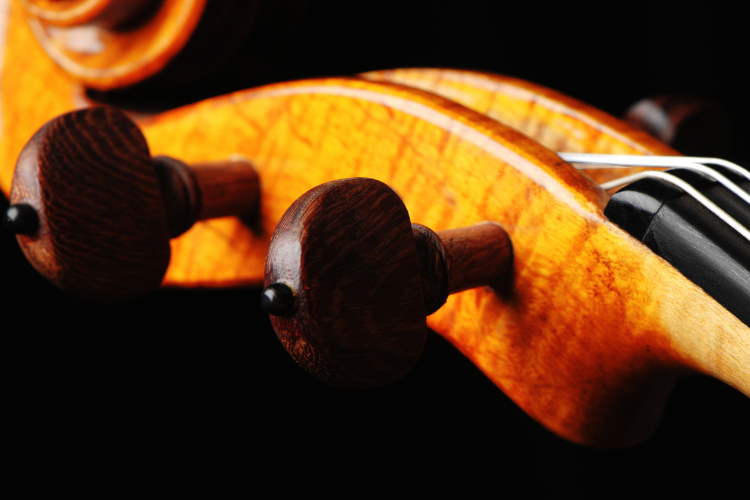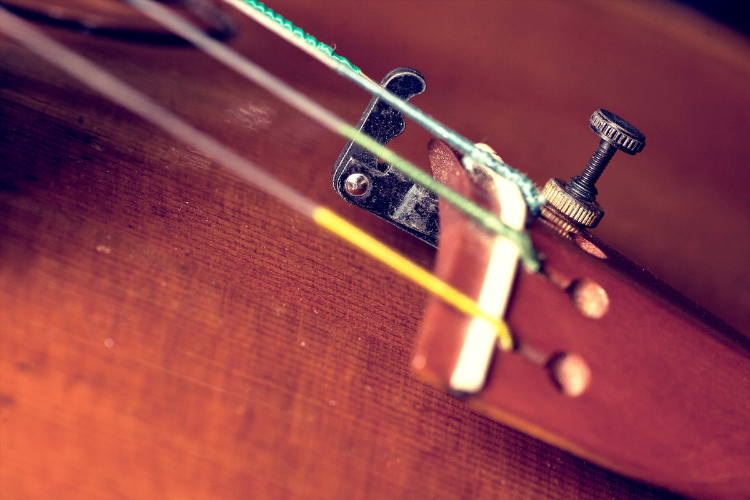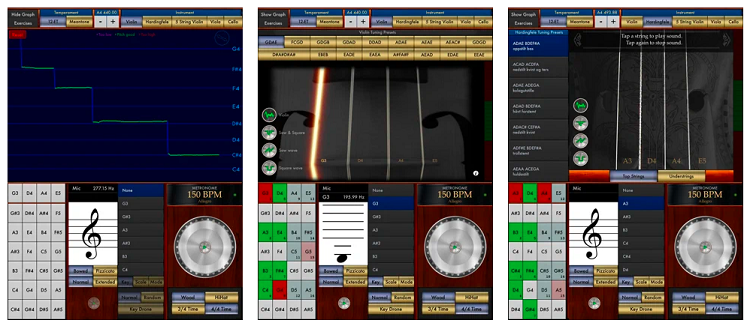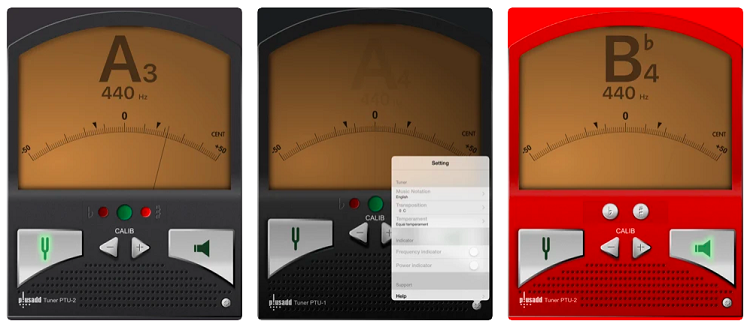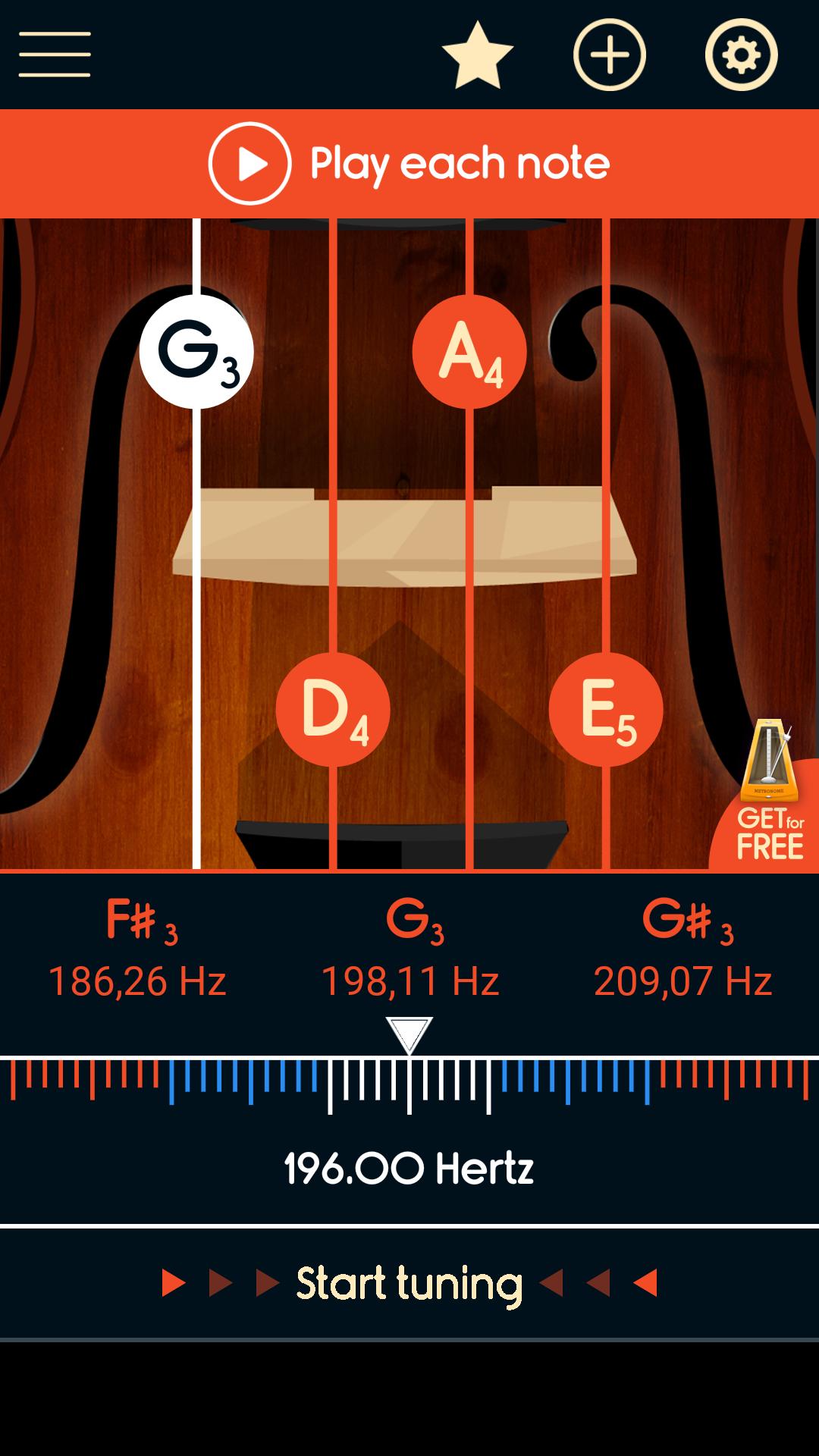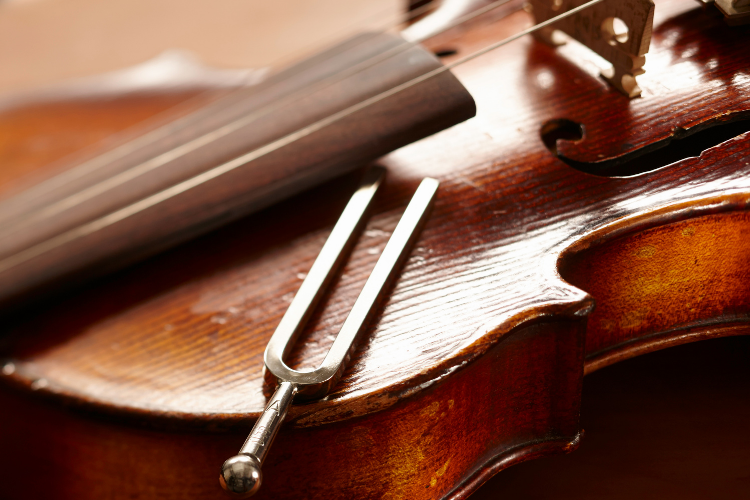- How to Find the Best Violin Shoulder Rest - April 12, 2022
- How to String a Violin – A Guide to Changing Violin Strings - April 3, 2022
- How to Tune a Violin: A Guide to Tuning the Violin - March 21, 2022
Tuning a violin may seem simple, but as any musician new to the instrument knows, this simplicity is deceptive! Pegs or fine tuners? Perfect fifths or string-by-string? Tuning apps? This guide will explore different techniques, tips, and tuning to other instruments.
Bottom Line Up Front: Find a precise A440 Hertz and match your A string to it! Then tune the other strings relative to the A. When they’re exactly right, you’ll hear a clear and bright resonance. Be patient when tuning and do it regularly. The violin is hard enough to play as it is, don’t let the strings get in the way!
Pegs and Fine Tuners
The violin has two tuning mechanisms: the four wooden pegs below the scroll and fine tuners attached to the tailpiece. Not all violins will have fine tuners, and some will only have one for the E string. However, most violins for beginners will have four.
Fine tuners are easier to use than pegs because the pitch changes more gradually when you turn them. As it is hard to play on a violin that is even slightly out of tune, many players prefer to use fine tuners, systematically checking their instrument’s tuning throughout their practice.
The pegs should be used when the strings are significantly off-pitch, i.e. a tone away from where they should be. So, if the A string sounds like a G or a B, you shouldn’t use the fine tuner to rectify the pitch.
Tips for Using Fine Tuners
- Make sure they’re not turned too tightly, or they may get stuck.
- Similarly, make sure they are never too loose, or they might cause a rattle.
- The bottom of the tuner should be at least 2mm clear of the violin top.
- If you have an expensive instrument, check with your violin maker if it’s appropriate or not to use fine tuners as they add substantial weight to the tailpiece.
Tips for Using Pegs
- Simultaneously push and turn the peg so it doesn’t “turn itself out” of the peg hole.
- It’s normal to wrestle a bit with overly loose or stiff pegs: you can’t be gentle with them like with fine tuners!
- If your pegs keep slipping, or they’re seriously stuck, take the violin to a luthier. Changes in humidity or enlarged peg holes can affect your pegs, and I’m not a fan of much DIY when it comes to the violin…
How to Tune
Start with the A String
As all string instruments have an A string, ensemble, and orchestral tuning starts with getting the A right. This is usually A440 Hertz, although sometimes string ensembles tune slightly higher, to A441 or even A442. Given this widespread practice, it makes sense for solo tuning to start with the A string too.
Later in the guide, we’ll look at different tuning apps and forks you can use. The basic principle is to find a precise ‘A’ pitch and then turn the fine tuners or pegs to match it. Here is an exact A440 Hertz on youtube:
You can also use the ‘A’ on a piano or synthesizer. If you use another instrument like a guitar or recorder, make sure it’s correctly tuned; otherwise, it’s a vicious cycle!
Ideally, you turn the pegs/tuners with your left hand whilst you bow steadily with your right arm. To do this, you must be sure that you can support the violin with the weight of your head without giving it too much thought.
If in doubt, practice removing your left hand from the violin neck, and ask your teacher about posture. Tuning whilst bowing takes a while to master, so don’t be disheartened if you find it difficult at first!
Tuning the Other Strings
Perfect Fifths
Once you’ve got your A string right, you can use it to tune the D string. Play both strings together, and you should hear a perfect fifth. This interval is easy to identify, as it resonates clearly and brightly when ‘perfect’. If the D string is even a tiny bit sharp or flat, you won’t hear that clear resonance.
You can repeat this process for the other strings:
D-G
A-E
I think it’s worth learning how to tune with this method and becoming accustomed to the sound of the perfect fifth, even if it’s not strictly necessary with tuning apps. As we’ll see later, orchestral practices require string sections to tune simultaneously, so there’s never the quiet ambience required for using an app.
String-by-string
For beginner violinists, it can be challenging to play two strings together with the clean bow stroke required to hear the perfect fifth interval properly. The best way around this is to tune each string individually to an app or piano. Still start with the A string; it’s good practice for later!
Many beginners leave the violin tuning for their teacher to do, which means the instrument only gets tuned once a week, at most! I encourage my students to try to tune from the first lessons, or if they’re very young, for their parents to learn how to tune for them.
Playing Tips when Tuning
- Take the time. Tuning can take a while, whatever level you are. Sometimes our ears don’t ‘hear’ the pitches properly, or sometimes we think we’ve gotten it right, and after a few seconds of playing, we realize we didn’t. It can be frustrating to take the time, especially if there’s not long to practice or other players are waiting for you to be ready.
- Use tuning to warm up. You will probably tune better and more efficiently if you treat tuning as the beginning of your warm-up and focus on fluid, slow bow strokes and a continuous sound. Try not to see it as a dull, potentially time-wasting necessity, but as physical and mental preparation for playing.
- Bow with clean, medium-strength strokes to hear the strings’ resonance. Aim for an mp to mf dynamic: not too quiet and not too loud. It’s unnecessary to use the whole bow; stay in the middle-upper half where it’s easier to bow cleanly. You can then extend to whole-bow strokes as a warm-up technique.
- Test with harmonics if you’re unsure. Lightly placing a finger mid-way along a string will produce a natural harmonic, one octave higher than the open string. Play mid-way harmonics on two strings simultaneously: as the resonance is restricted, it’ll be easier to hear if the perfect fifth interval is correct or not.
- Tune regularly throughout your practice. There’s nothing more frustrating than working hard on a passage because the intonation is off, then realizing that it’s just the string that went a bit flat! Pizzicato and ‘fortissimo‘ playing are likely to loosen a bit of the string tension. If you tune in one place and then move to another (like backstage and onstage), you should re-tune, as micro-changes in temperature and humidity will affect the strings.
Tuning Forks
A tuning fork is a handy accessory that you can keep in the pocket of your violin case. Hit a hard surface like a table or chair-leg with the fork, then hold it up to your ear to listen to the A400 pitch.
Some musicians strike their upper leg or wrist with tuning forks (and my partner has the visually bizarre habit of hitting his head with it) –if you might do this, it’s a good idea to get one with rounded tines as opposed to square ones.
This is an inexpensive, good-quality fork that is small enough to fit in your case.
Tuning Apps
Tuning apps have become an essential accessory for many instrumentalists. They all work roughly the same way: you play a note, and the app tells you how close it is to the desired pitch. Many violinists have gone a step further and practice their pieces with tuning apps to perfect their intonation.
While apps have done wonders in removing the stress from tuning, they have also removed the skill. Personally, I like the old-fashioned way that requires my ear to do some work. It puts me in the right state to begin playing and quite literally be ‘attune’ to what I’m doing.
Every violin has a precise point at which the open strings resonate when played together. This point is not exactly the ‘official’ perfect-fifth that apps (or pianos) establish (technically known as equal temperament), so your violin might still sound marginally out of tune if you use the app for every string.
‘Pythagorean A’ temperament will bring the violin closer to resonating perfect fifths. You can change the temperament settings on your app and usually the ‘sensitivity’ settings, although some apps will require you to upgrade to a paid version to do so. I still suggest tuning the A string with the app and then, as described above, tuning the other strings by ear.
Here are three good quality apps I recommend trying:
Violin Multi-Tuner – $1.99
Compatible with mac and android, this string-specific app is helpful for beginners, as the visuals highlight the violin string you are playing. It’s geared to a more “string by string” tuning approach, but you can use it any way you like, and there’s a range of inbuilt features like a metronome, ear training exercises and alternative tuning set-ups.
Tuner Lite by Plascore – Free for the Basic Version
I really like the needle meter and LED visuals on this app and can tune surprisingly quickly with it. The full version costs $4.99 and is only compatible with Mac devices, 11.0 or later.
Master Violin Tuner – Free with Ads
It’s straightforward to change the settings in Master Tuner if you need to tune to another pitch than A440 Hertz. The ads are quite annoying, but if you put your device in flight mode, you’ll receive less of them.
Tuning from a Piano
Pianos retain their pitch remarkably well. Unless they are subject to extreme temperature changes or are moved around, they only need to be tuned about once a year. Electric pianos and digital synthesizers never go out of tune; however, analogue synthesizers can do. If you have access to a piano, use the A4 pitch to tune your violin.
If you are playing a piece accompanied by piano, you must always tune to that particular piano, even if it’s out of tune. In the end, pitch is relative, so it’s much more important that all the instruments match each other rather than matching A440 Hz. If you find yourself in this situation, match the A precisely to the piano, then tune your violin in perfect fifths.
It can be helpful to hear a D minor chord when tuning your A string. First, sound the ‘A’ on the piano, add F (a third below) and D (a fifth below).
Orchestral Tuning Practices
In orchestra, there are fixed protocols for tuning. Typically, it happens like this:
- Everyone is seated and ready to start.
- The principal violinist stands up and asks the principal oboeist to play an A (oboes have a steady, clear sound, and their pitch doesn’t change easily)
- Depending on the orchestra’s size and etiquettes, this A will be re-sounded for each section in a specific order.
- When it’s time for the strings to tune, the lead violinist might take the A from the oboe first, then pass it on to each string section separately.
- When it’s the violin I or II’s turn, you should first tune you’re A, and then wait until everyone has it and the leader sits down before tuning the other strings.
- It can be tricky to tune at the same time as so many other violinists, and unfortunately, there is usually the pressure to do it quickly. If you’re feeling uneasy, you can always get your violin ready beforehand and even ask the oboeist or conductor which A they will be using: A440, A441, A442, etc.
Orchestral Tuning Tips
- Arrive at rehearsal well in advance. If anything has happened to your violin’s tuning (or any other issue with scores, etc.), you should have time to solve it before rehearsal starts.
- The tuning process is easier when violinists play softly. Stay at the tip of the bow and don’t get louder even if it’s hard to hear: it’s more efficient to be the last one tuning than trying to play louder than everyone else!
- If you’re the principal violinist for an extended time, try to find out which tuning methods best suit the players. Perhaps the double basses don’t want to tune together with the cellos, or maybe the string sections would like to take the A directly from the oboe, not from you.
- In some orchestra concerts, the lead violinist has a solo entrance onstage after the other players have arrived and tuned. In this set-up, it is the concertino who tunes. If you have either of these roles, make sure you know beforehand exactly what’s expected of you for the concert.
- It’s a good idea for the whole orchestra to tune backstage before a concert, as ‘long tuning’ is almost impossible when there’s an audience waiting. This is a perfect occasion for tuning apps! If everyone knows what A the oboe will give, they can tune themselves beforehand and risk very little. Of course, this is less useful if there is a long walk between backstage and stage or endless speeches before the concert starts.
Tuning in a String Quartet/Small Ensemble
Very few string players = the hardest tuning situation of all! While the instruments in a large orchestra have a blending effect, the individual voices in a small ensemble are distinctive. If everyone tunes in perfect fifths (ideal for solo playing), the bass instruments will sound flat and the violins sharp.
The best way to verify this fact is for everyone to tune, then a violinist to play an open E and a cellist to play an open C. It won’t sound good! One solution is to ‘tighten’ the perfect fifths. With the A, make the E as low as possible whilst still sounding in tune and the D and G as high as possible.
Alternatively, everyone tunes to equal temperament, i.e. the precise pitches on an app or piano.
Alternative Tuning
Tuning to A440 Hertz has only been an accepted norm for a few decades. For many centuries, the A pitch would differ from place to place, often depending on how the nearest pipe organ was tuned. So if the A on the organ in a small German town in the 17th century sounded like a D flat, then string instruments would tune their A string to D flat, which would have been called ‘A’.
Two principal alternative ‘A’ pitches are still used today: A415 Hertz and A432 Hertz.
A415 Hertz
The modern standard for baroque tuning is A415 Hertz, which sounds like a G sharp. Historically, tuning would have varied in the baroque period, but it would have rarely been as high as A440 Hertz. Less tension is produced by tuning to A415 (the higher you tune, the more pressure bears down on the bridge) which better suits gut-stringed instruments.
A432 Hertz
The trend of tuning to A432 instead of A440 came about because of mathematical and spiritual concepts linked to the number 432. Some people nurtured the belief that music played in A432 Hz had beneficial properties and special powers.
Furthermore, the A440 standardization is linked to the Nazi Party in the 1930s (although it was already the norm in several countries before that) because they accepted and promoted it. You may come across bands and ensembles across all genres of music that prefer to tune to A432.
FAQs
Answer: Almost always, but not 100% of the time! Some pieces require scordatura, where one or more strings are tuned to a different pitch. Most scordatura works are either from the baroque period or contemporary. The entire piece can be in different tuning (Biber’s rosary sonatas, for example) or require the violinist to re-tune at a specific point (Schnittke’s ‘MozART’, 2nd violin part).
Answer: Yes, if you’re not comfortable releasing your left hand, you can alternate bowing and adjusting. However, this takes considerably longer, and you might find yourself making do with unprecise tuning. If you’re a beginner and your teacher is tuning your instrument precisely every week, that’s fine; you’ll get the hang of it soon 🙂
Answer: You should tune before playing, every time. Check your open strings at regular intervals as you play to make sure they haven’t changed pitch – it happens very easily!
Answer: The only strings which quickly lose their pitch are gut strings. You may find that some modern makes with a gut core like Pirastro ‘Passione’ or ‘Oliv’ are more susceptible to going flat. All metal and synthetic strings are similar in their ability to retain pitch.
Answer: Strings can break at any time! If you haven’t played your violin for a while and the strings are old, a sudden turn of a peg may snap one. However, if you play regularly and the strings are in good condition, there is no reason why tuning should break one.
Answer: Yes, the tuning mechanisms and techniques are the same for all string instruments.
Answer: There is usually no problem in putting fine tuners on a full-size violin. However, you should consult your luthier first – they might recommend that you buy a sturdier tailpiece or have a new bridge fitted first.
Conclusion
I hope this guide has answered your tuning questions and inspired you to try different methods and techniques. If you enjoy the time you simply draw the bow across the open strings and listen to them, you’ll go on to enjoy your playing more too!
Looking for more interesting readings? Check out:


